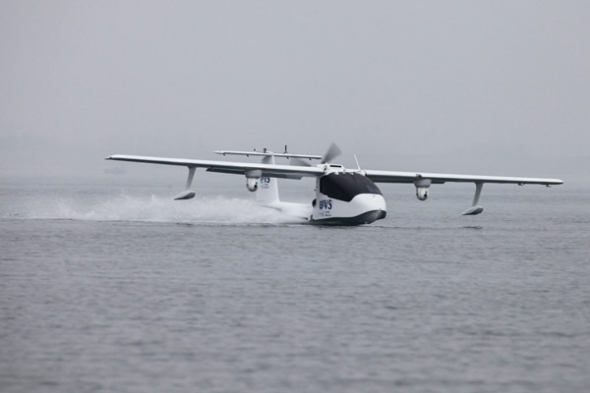World’s first amphibious drone made in Shanghai

A U650 unmanned amphibious aircraft undergoes tests in Central China at the end of 2016. (Photo provided to China Daily)
A Chinese company has produced the world’s first unmanned, amphibious commercial aircraft, with plans to use it to deliver goods, transport supplies to islands and detect submarines, according to the manufacturer.
Liu Jiandong, founder and chairman of UVS Intelligence System, a privately owned drone-maker in Shanghai, said mass production of its U650 seaplane has begun and will enter commercial operation this year with a Chinese express delivery company and a client in Southeast Asia.
He declined to name the buyers, citing business confidentiality, but said both contracts had “considerable value”.
“We are working with the domestic client to apply for approval from air traffic management authorities of our plan to open a freight route next year using the amphibious drone,” he said.
The U650 was developed based on Spain’s Colyaer Freedom S100 amphibious ultralight aircraft, whose intellectual property rights were wholly acquired by the Shanghai company, according to UVS.
The amphibious drone carried out its maiden flight from waters in Central China in December 2015, the company said.
The 5.85-meter-long unmanned seaplane, made of carbon fiber, is able to stay aloft 15 hours with a cruising speed of 180 kilometers per hour and a flight range of 2,000 km. It is capable of takeoffs and landings from short unpaved airstrips, grassland or water.
The drone can carry up to 250 kilograms of cargo and its wings can also carry four payloads, such as inflatable life rafts.
Liu said his company sees domestic and foreign couriers as the U650’s primary users. It expects the model to be a commercial success because “it is the only civilian drone in the global market that is capable of ferrying cargo with a total weight of 200 kg or even heavier”.
Express delivery enterprises along China’s eastern and southern coastal regions will find the U650 useful, he said. Those areas are densely populated and have busy airline operations that lead to many restrictions when it comes to drone flights.
“Our aircraft can fly above, and land on, water. Its range is much longer than those of small types, so it doesn’t need to make stops during a delivery mission. It will not risk the safety of people or airliners,” Liu said.
Almost all of China’s large couriers, such as China Post and SF Express, have begun to invest in research and development on delivery drones. Analysts have said drones will play an increasingly important role in the country’s skyrocketing online shopping industry.
Globally, Amazon and DHL Express have deployed drones for delivery service on a small and experimental scale, and are continuing to design new models.
In addition to couriers, U650 will also be able to benefit Chinese troops and residents on islands and reefs in the South China Sea, Liu said.
“It can be used to transport supplies to those islands and reefs many times a day at a low cost while ships and manned planes are subject to weather and expenditure considerations,” he said. “Meanwhile, the deployment of such drones will make it possible for those living there to have access to online shopping, which they are unable to do now because of the absence of delivery service.”
The U650 is capable of carrying out reconnaissance and strikes for the military thanks to its ability to carry radar, sonar or missiles.
“For instance, the drone can remain afloat at sea to tow sonar to detect submarines and move rapidly to other areas to continue the search,” Liu said.












